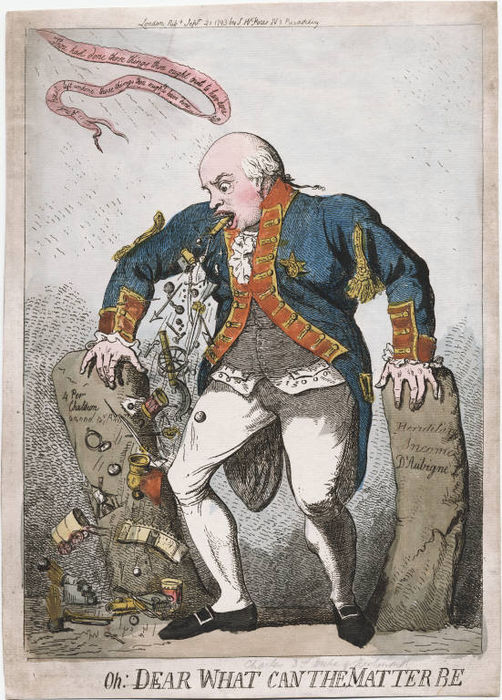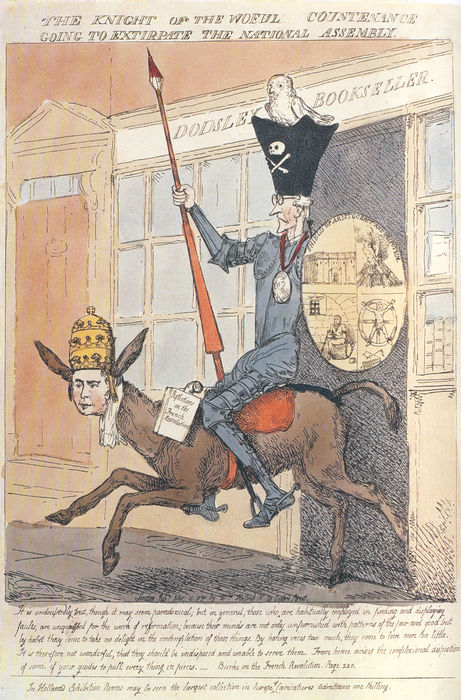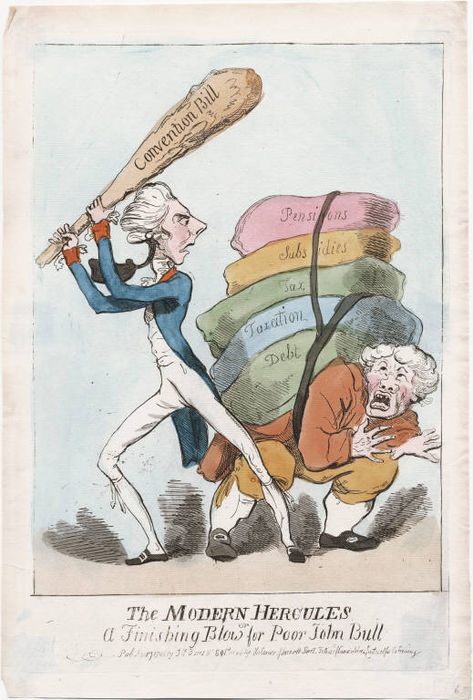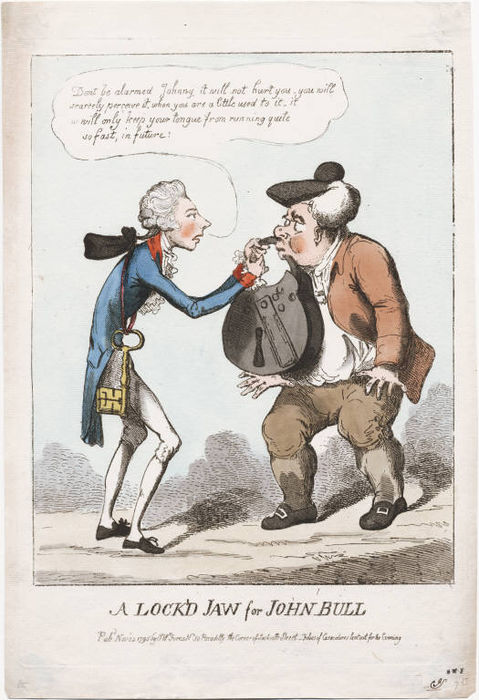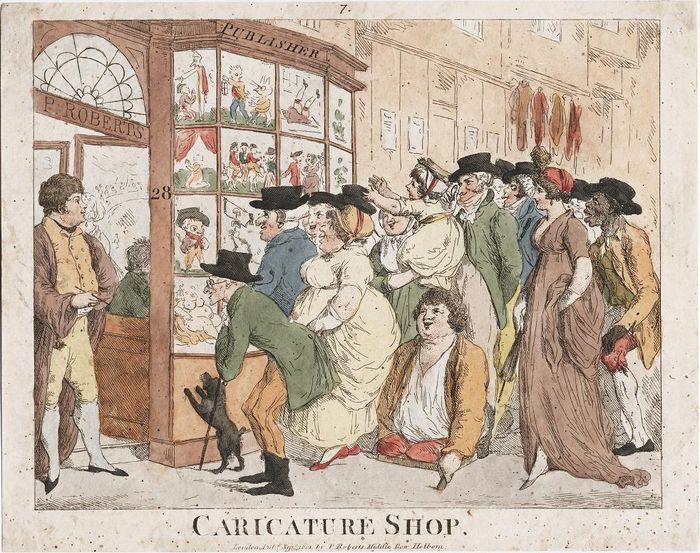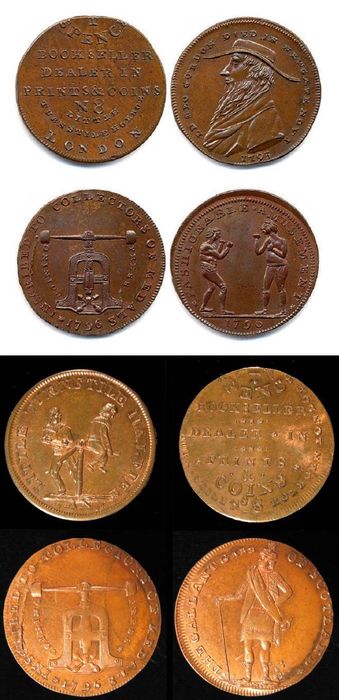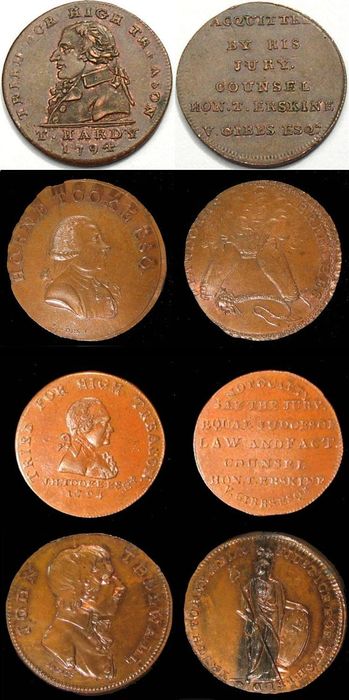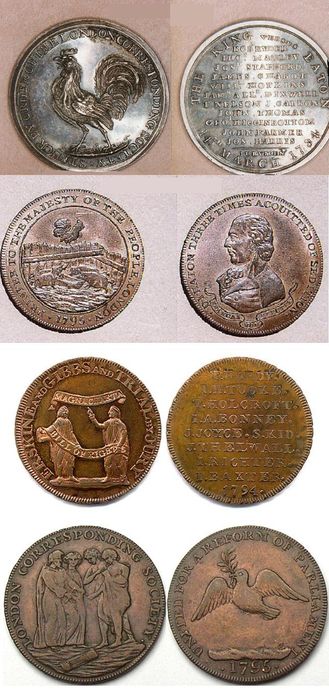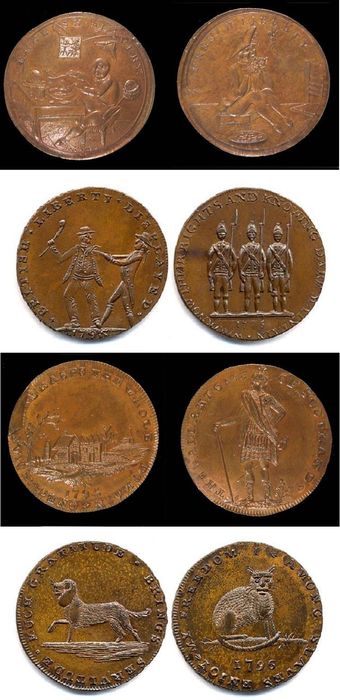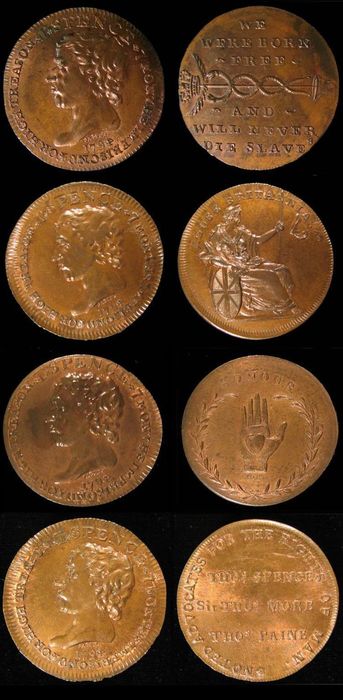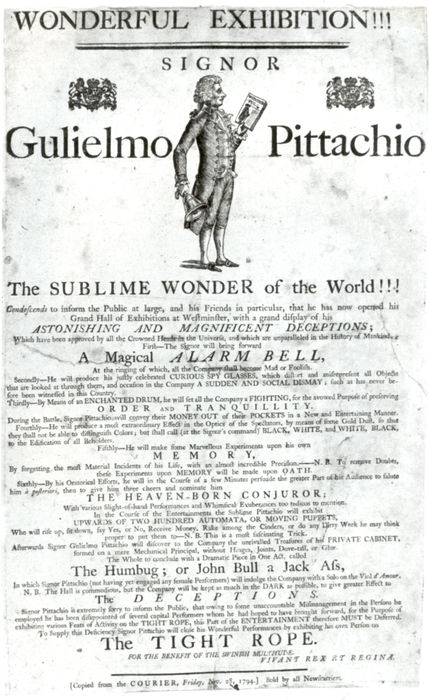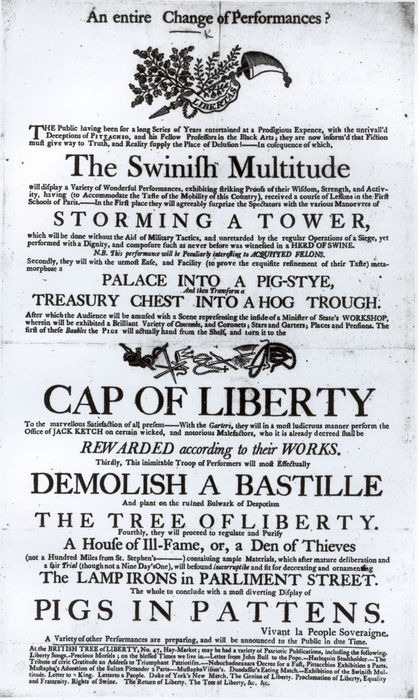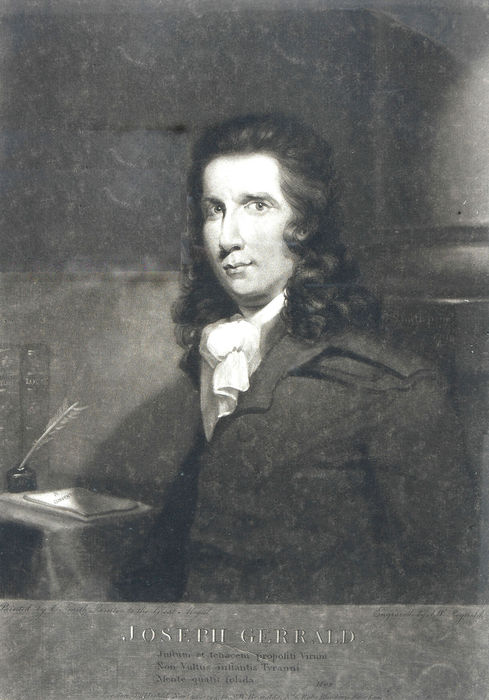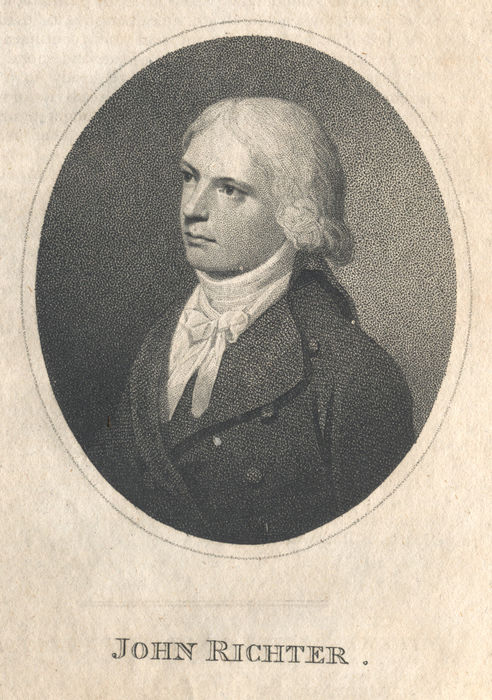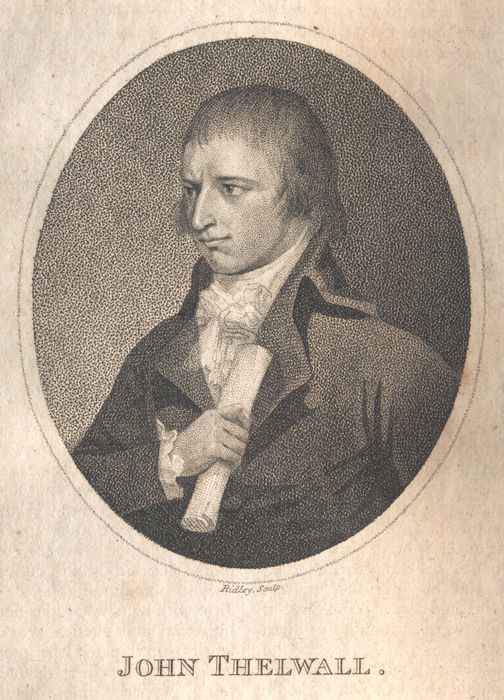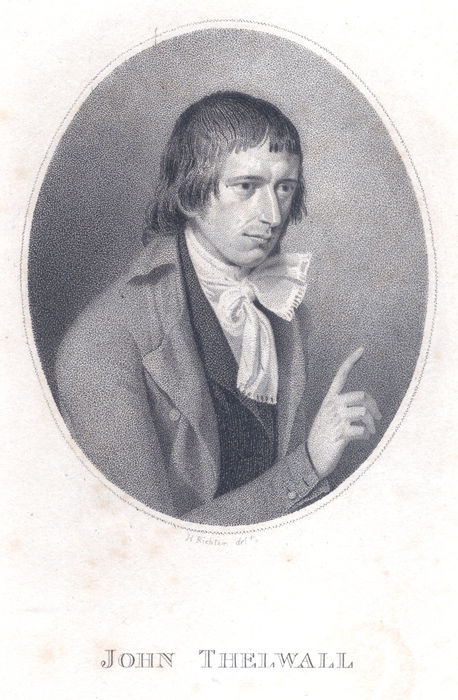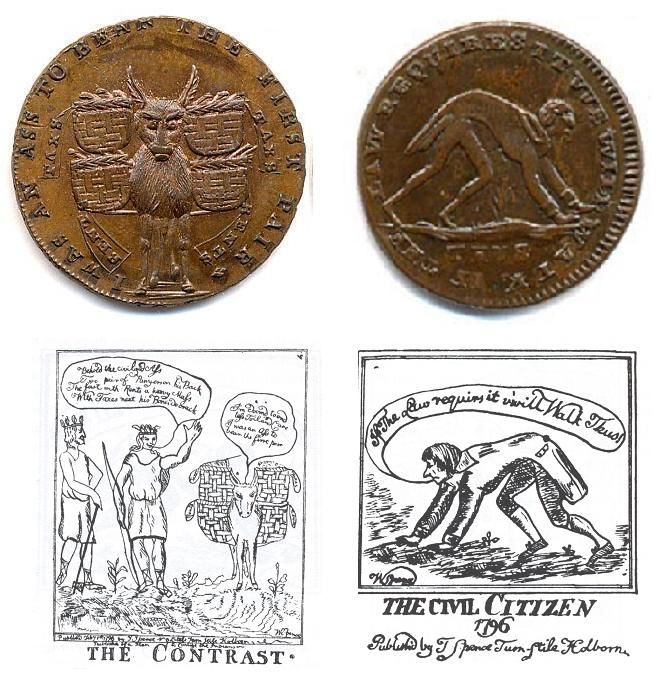Abstracts
Abstract
This essay examines the visual propaganda produced by the popular radical movement in the 1790s, chiefly in London. It examines examples of caricatures, especially those by Richard Newton, the token coinage mainly produced by Thomas Spence, the mock play-bills printed by Richard ‘Citizen’ Lee and others, and the portraiture of contemporary radical leaders and heroes published by or on behalf of the movement. It discusses the effectiveness of these as radical propaganda, but its main concern is to ask why the movement seems to have been so little interested in developing a visual culture commensurate with its varied and voluminous literary culture. It looks for the answer chiefly in what it suggests may have been a strong distrust of the visual among popular radicals, and a concern that to exploit the resources of the comic and the grotesque in visual propaganda would have made the movement appear less high-minded, less polite, and easier to despise and dismiss.
Article body
I.
Early in 1794, during the alarm created by the war with the new French republic and the popular movement in Britain for universal manhood suffrage, Daniel Isaac Eaton’s periodical Politics for the People, or, A Salmagundy for Swine, published a series of verses which claimed to describe some of the caricatures displayed in the window of a print-seller in Coddletown, the imaginary rotten borough from which one of the periodical’s correspondents, Gregory Grunter, sends occasional reports (52-4).The print-shop belongs to a man called ‘JACOBIN’, whose name strikes terror in the loyal burghers of the borough, and especially in its alarmist mayor, Gaffer Greybeard. The caricatures Jacobin is selling include images of three enemies of parliamentary reform and keen supporters of the war against the French Republic. Isaac Cruikshank’s satire Oh Dear What can the Matter Be (fig. 1) is an attack on the Duke of Richmond, Master of the Ordnance, whom the opposition press blamed for failing to supply the British army with sufficient artillery during the siege of Dunkirk. William Dent’s Call of the House (fig. 2) imagines Prime Minister William Pitt as a kind of corrupt Christ, scattering the loaves and fishes of patronage, or bribery, on his venal supporters. A third satire is described as representing ‘the Arch Apostate’. Richmond and Pitt, both formerly vigorous supporters of parliamentary reform, have a fair claim to this title, but the verses themselves leave no doubt about whom is intended:
Arm’d cap-a-pee, with spectacles and lance,
To kill the millions of OPPRESSED France,
With ghastly smiles behind his gorgon shield,
ST. OMER’s JESUIT, trembling, takes the field,
His coat of mail, his carcase, and his spear,
And all his pranks, the wretched SWINE must bear.
This is Edmund Burke, once the enemy of government corruption and the friend of democratic revolution, now the defender and beneficiary of state bribery and the man who had orchestrated, so British radicals believed, the alliance of kings against France. In the print devoted to him – and it is not clear that Eaton has any one specific print in mind - Burke appears as an amalgam of two characters he had assumed in various recent caricatures: Don Quixote, or rather Don Dismallo, Knight of the Woeful Countenance, unaware that the age of chivalry was long gone (fig. 3); and the Jesuit priest, supposed friend of the catholic church in France, and abettor of the Prince of Wales’s clandestine and illegal marriage to the catholic Mrs Fitzherbert (fig. 4).[1]
Figure 1
Figure 2
Figure 3
Byron, Frederick George [?]. The Knight of the Woful Countenance. William Holland, 15 November 1790: BM 7678
Figure 4
From 1793 until the end of the century there were very few anti-government caricatures of the kind Eaton imagines being published, almost none indeed that appear to emerge from a point further left on the political spectrum than that occupied by the Foxite Whigs. To some degree we have concealed from ourselves the overwhelmingly loyalist character of political graphic satire in the 1790s by our habit of finding ambiguities in caricatures that do not seem to have been noticed at the time, as well as by the assumption that, because Gillray, the leading caricaturist of the decade, was so hostile to Pitt, he must have been hostile too to the policy of Pitt’s ministry. After the foundation of the Association for the Preservation of Liberty and Property against Republicans and Levellers in late 1792, and the appearance, early in 1793, of affiliated associations throughout England, keen to hunt out sedition wherever they could find it, the very notion of a jacobin printshop in London, let alone in a rotten borough where Eaton imagines it, is almost beyond imagining.
Before the great political polarisation of 1792, William Holland, whom the Times indeed described as a ‘jacobin’ publisher, ran a printshop in fashionable Oxford Street where he published the satires produced by his brilliant teenage protegé Richard Newton (Alexander 34). Holland was indicted in December 1792 for selling Paine’s Address to the Addressers, but apparently with the aim of stopping him selling radical caricatures. With the same aim the Birmingham publisher William Belcher was also prosecuted for publishing Paine’s Address (Gatrell 493-4).The pornographer John Aitkin, who with the brothers John and James Roach had taken over the publication of Harris’s List of Covent-Garden Ladies, the long-established guide to the more expensive prostitutes working in London, was prosecuted and fined in 1795 for publishing the list, with the effect, if not the intention, putting a stop to the radical caricatures he had published, very occasionally, in the preceding years (The Courier 10 June 1795; True Briton 10 Nov. 1795).[2] As a small final act of defiance he produced in July Billy’s Hobby Horse (fig. 5), just after the open-air general meeting of the LCS at St George’s Fields depicted in the right distance, with Pitt driving George III as John Bull as a broken down pack-horse loaded with the weight of taxes imposed to pay for the war. This was a moderately offensive literalisation of Gillray’s famous Presages of the Millenium of the previous month (fig. 6), in which Pitt rode the king in the figurative shape of the white horse of Hanover.
Figure 5
Figure 6
There was a brief flowering of anti-government caricature in the last two months of 1795, a protest led by the relatively liberal Piccadilly printseller S.W. Fores against the infamous Two Bills introduced in November, and in particular against the increase in the penalties for seditious libel set out in the Treasonable Practices Bill (figs. 7 and 8). But thereafter, except for a brief return to political caricature by Newton before his death in 1798, there is almost nothing. In short, what Eaton’s caricatures in verse purport to describe, a series of anti-government and anti-loyalist caricatures exhibited in a Jacobin print-shop window, to the consternation of men in power and authority, is a fantasy. They describe caricatures which have ceased to be produced, they describe images that cannot be engraved, conjuring up satires in verse as if to supply their absence from the shops.
Figure 7
‘Temple West’ (attrib.). The Modern Hercules or A Finishing Blow for Poor John Bull. S.W. Fores, 17 November 1795: BM 8687.
Figure 8
‘Temple West’ (attrib.). The Modern Hercules or A Finishing Blow for Poor John Bull. S.W. Fores, 17 November 1795: BM 8687.
When at the end of the eighteenth century satirical prints are described as if seen in print-shop windows, the point is always that there they are available to be seen by a promiscuous public, but one chiefly made up of those who cannot afford to buy them (fig. 9); and this is usually regarded as a serious social and political problem, ‘a great and public nuisance’, as the periodical The Ranger put it in 1794 (170). During the brief flowering of anti-government caricature at the end of 1795, it became the turn of the Treasury-funded newspaper the True Briton to worry that in print shop windows ‘the most seditious Publications’ were now being ‘exhibited to the gaping multitude’ (True Briton, December 23, 1795).[3] ‘As to these here print shops,’ says a character in a novel of the early 1790s, ‘I see no manner of use they are of, except to make people spend their time in gaping at what does not belong to them’ (Terentia 69). Versions of this anxiety are frequently found in the late eighteenth century. Sometimes the prints that seem to cause most anxiety are those that threaten to corrupt by their sexual content, sometimes by their politics. Vicesimus Knox even goes so far as to suggest that among the causes of the Gordon Riots was the exhibition of caricatures of leading politicians in shop windows, where they must ‘diminish and destroy that reverence, which is always due to legal authority, and established rank’ (140). This is exactly Eaton’s idea in Politics for the People: a wish that the popular radical movement could, through caricature, through the print-shop window, reach this plebeian public on the street, and teach them to despise, not to admire their masters. The wish is presumably entertained for the very reason that strikes anxiety in so many writers: the fact that caricatures can communicate to the illiterate, as seditious pamphlets cannot, and the fact that visual imagery was supposed to communicate with an immediacy beyond that of language, and thus was more liable to inspire an immediate response.
Figure 9
Anon. Caricature Shop. Lewis Walpole Library, Farmington, CT.: P. Roberts, September 1801: lwpr 10184.
In fact however the popular societies working for a radical reform of parliament in the 1790s produced very little significant visual political culture. I find this surprising for all sorts of reasons, which means this essay will have nothing very tidy or decisive to say about why it may have turned out that way. The movement for universal manhood suffrage was fostered in the 1780s by the Society for Constitutional Information, whose very name suggests that it was aware that achieving its aim would require the invention of a new, popular political culture. The plebeian societies that developed in London, Sheffield, Edinburgh and elsewhere in the 1790s understood this to be their task too, hence the decision of the London Corresponding Society that for every meeting of its affiliated divisions held to discuss specific proposals and policies, they were to hold another at which political texts were read aloud and discussed, with everyone present obliged to contribute. Hence too the remarkable number and variety of radical publications produced by plebeian publishers in London especially in 1794 and 1795: pamphlets, periodicals, poetry, songs, satires of every kind, and so on. Some of the output of these publishers was recycled from more polite sources, but by 1795 a significant proportion of popular radical publications appear to have been written by plebeian authors.
The variety of these publications shows that the popular radical movement, especially in London and Sheffield, was also thoroughly committed to exploring the means of propaganda at its disposal. The Secret Committee of the House of Commons, reporting on the evidence that had been collected following the arrests and the seizures of papers in May and June 1794 which led to the treason trials of later that year, became fascinated by what it saw as the dangerous resourcefulness of radical propaganda. Some of that fascination is no doubt to be put down to the alarmism which, for many loyalists, hugely magnified the threat posed by the movement. The committee no doubt exaggerated the propensity to enthusiasm among those to whom this propaganda was addressed, and so exaggerated also its likely effect, but it was not wrong to insist upon the ingenuity with which the movement attempted to win adherents. The movement, the committee reported, used ‘every possible artifice’, to disseminate its principles (Parliamentary History 31: 708). ‘Some of these means,’ it told the Commons,
may at first sight be considered as too trivial to be mentioned on an occasion of this importance, but they appear to your Committee in a very different light, when they recollect than an essential part of such a plan as has been in agitation, was to seduce and corrupt the thoughtless and uninformed, and to make use of the channels of communication best adapted to this purpose. The appearance of insignificance and levity, which belongs at first sight to this part of the system, is, in truth, only an additional proof of the aim and industry with which it has been pursued. The measures employed for this purpose appear to have been deliberately prepared, and every contrivance used to mix them (in the shape most likely to captivate attention) with the ordinary occupations and amusements of those on whom they were intended to operate.
Parliamentary History 31: 708
These measures include lectures ‘calculated from their very extravagance to catch the attention of the audience’, on ‘every topic ... that could inflame their minds’; ‘violent’ handbills, covering ‘every point that could excite discontent’, secretly but widely circulated; political satires in the form of mock playbills; songs, seditious toasts, and ‘a studied selection of the tunes which have been most in use in France since the revolution’ (Parliamentary History 31: 708). By all these means the popular reform societies are accused of ‘endeavouring to render deliberate incitements to every species of treason familiar to the minds of the people’ (Parliamentary History 31: 708).
‘Every artifice’, ‘every contrivance’, ‘every topic’; ‘every point’, ‘every species of treason’: the report is concerned to suggest that the propaganda effort of the popular reform societies is as comprehensive as could possibly be imagined. It is so carried away by its rhetoric that even as it points out the danger inherent in the kind of irreverent levity that caused Knox such anxiety in political caricatures, it does not notice that the societies have nowhere been found making any marked use of visual propaganda. It marks a remarkable contrast between the popular radical movement in the 1790s and other political movements and societies in the late eighteenth century that the former made no attempt to give themselves or their beliefs any visual identity, except for a few like John Thelwall who, with no employers or customers to propitiate, could at least wear their hair cropped as a visible badge of principle. The members of polite political clubs of course could afford to wear uniforms, custom-made buttons, coloured cockades, as the popular societies could not. But think how ubiquitous in the 1760s were images of Wilkes or the number 45 on everyday objects: on tobacco papers, ballads, prints, broadsides, buttons, buckles, snuffboxes, brooches, earthenware or porcelain mugs, teapots and punchbowls (Cash 119, 219). Think of the use made of the visual by the plebeian Wilkites of the 1760s who wore blue cockades and carried old boots on demonstrations to symbolise the ministry of Lord Bute, and petticoats to stand for the alleged petticoat government of the Dowager Princess of Wales, or who simply chalked the number 45 on every door so that even the innumerate soon learned the ciphers that added up to ‘Wilkes and Liberty’ (Cash 160, 210, 212, 222). There is no obvious equivalent attempt by the radical societies of the 1790s to convey meanings and spread ideas by visual means.
We cannot put this down entirely to government or loyalist repression. As Vic Gatrell has pointed out, it was far harder to bring a charge of seditious libel against those who sought to convey unwelcome political meanings by visual means than it was to prosecute the publishers of political pamphlets (485). To prosecute seditious libels, the law officers had to state precisely what they took the meaning of the supposed libel to be, and to convince the jury that their reading of it was correct. Even when everyone understood perfectly well the meaning of an image, a picture, a visual symbol, there was an irreducible indeterminacy about the visual which made paraphrase or ekphrasis always inadequate, and made the defence, that the image had been misunderstood, always available. The written word was regarded as far less indeterminate and so far easier to prosecute, and yet the radical movement in its heyday was responsible for an astonishingly high volume of print-publications, so many in 1795 that the Attorney General was forced to admit that the publication of seditious libels was far too prevalent to be controlled by legal means.
II.
There is arguably one obvious exception to the claim that the reform societies, for all the urgency of their propaganda effort, for all their apparent need to communicate with the less than fully literate, did not seek to disseminate the reform agenda by visual means. I am thinking of the token coinage issued in particular by Thomas Spence, the Newcastle-born writer and propagandist who in the 1790s was living in London and was a member of the LCS.[4] Before I say something about these, we’ll need some context. From the mid 1780s or so to the end of the century, there was an extraordinary explosion of copper token coinage throughout Britain. The main reason for this was the shortage of low-denomination specie: virtually none had been minted since the 1750s. Some manufacturers took advantage of this situation by manufacturing tokens, and selling them in bulk at about 70% of their face value to whoever would circulate them (Waters, Notes on Eighteenth Century Tokens V). Until 1797, when the government commissioned Matthew Boulton to make a new copper coinage, this was perfectly legal, and in the remote parts of the kingdom tokens probably continued in circulation for some years after that.
Some tokens, of which examples are reproduced in fig. 10, bore the names of businesses, were probably given as pay to employees, and were payable – that is, redeemable – for current coin; most did not and were not payable but were still widely accepted. These were followed by tokens issued by shopkeepers, which became fashionable in the early 1790s. These were not usually payable and were intended rather as advertisements or durable substitutes for trade cards, but the shortage of specie certainly led to some of these being circulated as well. By the middle of the 1790s, many thousand different copper tokens had been produced, and they were being avidly collected,[5] which stimulated yet further production, including tokens bearing loyalist or radical political propaganda, sometimes even loyalist propaganda on one side and radical on the other. The craze for token-collecting was fed by the publication of numerous descriptive catalogues produced between 1794 and 1798, including one by Spence,[6] and by numerous articles on the phenomenon of tokens and token collecting in the Gentleman’s and four of five other magazines.[7] Non-payable tokens began to be produced in great quantity, entirely to be sold to collectors. For a year or so this was Spence’s main line of business (fig. 11), his most reliable source of income, and he was describing himself as ‘T. Spence, Dealer in Coins’,[8] though by early 1797 his money difficulties forced him to sell his dyes to another large-scale manufacturer of tokens for collectors, Peter Skidmore.
Figure 10
Four trade tokens: from top to bottom, Salter’s hatmakers, Charing Cross, Middlesex no. 473 in Dalton & Hamer, henceforth D & H; Guest’s bootmakers (D & H 308); ‘For Change in Trade’, a halfpenny coined as a substitute for specie (D & H 1029); Hancock’s umbrella makers (D & H 320). All tokens illustrated in this essay are classified by Dalton and Hamer as originating in Middlesex.
Figure 11
Four tokens by Spence referring to his token coinage: from top to bottom, Lord George Gordon (D & H 696); boxers and a coining press (D & H 740); a turnstile (D & H 715; Spence’s shop was in Little Turnstile near Lincoln’s Inn); a highlander and a coining press (D & H 742). Notice the contrast between the uncirculated and circulated condition of nos. 740 and 742.
Radical tokens were usually the size of a penny, halfpenny or a farthing, and it is convenient to think of them as of two kinds, though the kinds overlap. There were, to begin with, a few penny and halfpenny-sized coins known by collectors as ‘medalets’, small medals struck in large editions in imitation of those issued to celebrate military and naval victories, for example, except that these commemorated the victories of the reform movement in the courts. Of those acquitted in the great show trials for treason and sedition in 1793 and 1794, for example, there are four different medalets for John Horne Tooke, and three for Thomas Hardy, and two for Eaton. None of these are now thought to have been issued by Spence, but he did produce medalets of John Thelwall and of himself, commemorating their acquittals and release from custody following the collapse of the 1794 treason trials. There is at least one medal showing the head of Thomas Erskine, lead counsel for the defence in those treason trials, and another purporting to show Erskine together with Vicary Gibbs, his junior in those trials. The reverses of these treason trial medals usually bear information relating to the trials, often the names of the jurors to whom the medals were probably presented (figs 12 and 13).
Figure 12
The radicals acquitted in the treason trials: from top to bottom, Thomas Hardy (D & H 1025); John Horne Tooke and ‘Pandora’s breeches’ (D & H 841); Tooke again (D & H 1046); John Thelwall and Minerva (D & H 866).
Figure 13
Tokens referring to political trials and to the London Corresponding Society: from top to bottom, Daniel Isaac Eaton’s game cock (D & H 203); Eaton, with game cock and swine (D & H 301); Thomas Erskine & Vicary Gibbs (D & H 1011); the fable of the bundle of sticks and the dove of peace (D & H 286).
These radical portrait-medals, for obvious reasons, were nothing like as desirable to collectors as the other variety of political token issued by Spence (fig. 14), halfpennies and farthings bearing designs, sometimes satirical like caricatures, or with political messages dressed up as folk wisdom or animal fables, with a brief, often punchy legend explaining the political point. These have been discussed very effectively by Marcus Wood in his book Radical Satire and Print Culture (68-82).
Figure 14
Four political tokens of the mid 1790s. The topmost, ‘English Slavery, ‘French Liberty’ (D & H 760), is attributed by D & H to Spence but is most unlikely to be his; the spirit of the imagery resembles anti-French caricatures such as Gillray’s ‘French Liberty, British Slavery’ of 1792 (BM 8145), or Cruikshank’s ‘French Happiness, English Misery’ of 1793 (BM 8288). The remaining three are certainly Spence’s: the first (D & H 729) contrasts the oppressed men crimped or press-ganged into the services with a free citizen-militia; the next (D & H 745) depicts a scene from Goldsmith’s Deserted Village, with a quotation from the poem and on the reverse the highlander who appeared in fig. 10; the bottom-most (D & H 751) contrasts a dog’s slavish eagerness to please with a cat’s freedom and independence.
Among serious collectors of tokens, Spence quickly acquired a bad name. This was partly, of course, on account of the political content of his tokens. To collect them, one antiquary declared, was to drink ‘from the very ditch of this dirty traffic’ (Gentleman’s Magazine 66: 754). Spence’s tokens, thundered another, were ‘contemptible in execution, and infamous in representation; ... beyond the revolutions of ages, and the decay of empires, they will carry the marks of his infamy to the final dissolution of the world’ (Gentleman’s Magazine 68: 830). The engraver Charles Pye, who issued a collection of engravings of tokens for the use of collectors, found them ‘so infamously base, that ... they are a disgrace to the age we live in, and such as I don’t think proper to admit into my collection’. He had compiled his catalogue with the help of Sarah Banks, the sister of Sir Joseph Banks, and if he shared the Banks’s ultra-loyalist politics he could hardly have tolerated Spence’s (Pye, Provincial Copper Coins, ‘Advertisement’, unpaginated).
Writers on token collecting were desperate to regulate the production of tokens, so that they could imagine some end to their pursuit. And their chief objection to Spence was his practice of continually varying the combination of dyes on the reverse and the obverse of his tokens. The medalet or token he produced of his own head, for example, is known with eighteen different dyes on the reverse (fig. 15), and almost every token he made is known with a variety of reverses. Charles Pye, James Conder and many others accused him of mixing ‘the obverses and reverses ... on purpose to make variety’, so as ‘to impose upon the publick’ (Gentleman’s Magazine 65: 991; Conder: n. pag.). Other token manufacturers did this too, but if it was an offence, Spence was the worst offender, interchanging his numerous dyes, as a correspondent of the Gentleman’s Magazine put it, ‘almost beyond the powers of calculation’ (68: 122).
Figure 15
Four tokens by Spence commemorating his imprisonment in 1794 on a warrant alleging high treason. From the top, the reverses show a caduceus between a crown and a cap of liberty (D & H 679); Britannia (D & H 678); a heart in hand (D & H 682) and a celebration of three Thomases, ‘advocates for the rights of man’ (D & H 677).
Marcus Wood argues that by this practice, in which ‘almost any combination for the obverse and reverse of a token was both possible and effective ... Spence promulgated his ideas through an ever varying series of juxtapositions’ (71). This may be too much a literary critic’s view of things. We can try to persuade ourselves that the endless combining of dyes was at the very heart of Spence’s politicising project: that he was inviting those who found a token in their change to make out a relation between its two sides, and thus to learn to think for themselves about politics by making hitherto unperceived connections. It seems to me more likely that the bewildering variety of combinations issuing from Spence’s shop taught those who came across these tokens to discount the idea that the two sides were meant to be related to each other at all.
The most interesting but also the most puzzling contemporary comment on Spence’s tokens was made by a contributor to the Gentleman’s Magazine in 1797, who described visiting Spence’s shop on Little Turnstile, where he saw
many many thousands of different tokens lying in heaps, and selling at what struck me to be very great prices. These, therefore, could not be considered as struck for limited sale. I confess, considering the number I saw struck, and what the subjects of them were, I thought myself justified in supposing that it was the intention to circulate them very widely.
Gentleman’s Magazine 67: 269
The correspondent is clearly confused by what Spence was about. Knowing him to be what loyalists liked to call ‘a violent democrat,’ he wants to believe that Spence is at the centre of a vast propaganda network, preparing to spread sedition by circulating his tokens by the thousand throughout the kingdom. He knows however that Spence is really in business for some quite other purpose. The tokens in Spence’s shop were selling at prices many times higher than their notional face value; his farthings at 12 or 16 times their face value. They were obviously not for circulation either as coin or as propaganda, and this writer is the only one in the 1790s who pretends that they are, if only for a moment. He knows they were being made to feed the insatiable desire of collectors, and the primary effect, perhaps even the primary purpose of their radical messages was to attract publicity and the attention of collectors.
Spence’s tokens are usually discussed as if they circulated in shops, taverns and street markets, spreading the radical word to the uncommitted poor. Wood claims that Spence’s tokens were circulating in Hastings, Birmingham, Newcastle, in Worcestershire, in Munster, but apart from in Newcastle, where Spence’s brother certainly sold them, this seems to be based on a misunderstanding (69). What happened was that, after he sold them to Skidmore, impressions from Spence’s dies turn up on tokens manufactured in, or simply depicting provincial locations. This belief however in the wide circulation of his tokens has meant that too much has been made of their propaganda value. It’s perfectly clear that the commemorative medalets by Spence and others, of Hardy, Tooke, Thelwall and so on, and of Erskine and Gibbs were designed for general circulation. They frequently turn up very well rubbed and worn, and have clearly been used like general trade tokens as a substitute for current coin. It’s most unusual, on the other hand, to come across circulated examples of the much more inventive side of Spence’s practice, the halfpenny and farthing tokens with designs like caricatures or with political messages dressed up as animal fables. Some were no doubt thrown by Spence to children in the street, as Francis Place tells us (Francis Place Papers, BL Add. MS 27808, fos. 182-5), in the expectation that they would quickly be spent and circulated, but the bulk seem to have disappeared in mint condition into the cabinets of gentleman and lady collectors, who may have enjoyed a mild alarmist thrill on seeing their message, - may even, like one of the correspondent’s to the Gentleman’s Magazine, have claimed to find them infamous, disgraceful - but probably did not feel in much danger of being radicalised by them. Safely laid out in drawers, such ‘sedition pieces’, as the Scots collector James Wright put it, ‘can produce no effect more important than that of licentious caricatures, which excite laughter, or incur contempt’ (67: 32). If we measure them by their likely effectiveness rather than by their marvellous wit and invention, I don’t see Spence’s tokens, fascinating as they are, as an important contribution to the creation of a visual radical propaganda.
III.
Another variety of propaganda with strong visual impact and appeal is the mock playbill, a satirical genre that the Committee of Secrecy listed as among the most apparently trivial but in fact dangerously resourceful examples of the societies’ attempt to corrupt the uncommitted and ignorant. The first of these, which may in fact have been an example of loyalist black propaganda, appeared in 1793, but the heyday of the radical mock playbill came after the committee’s report, from the end of 1794 to the middle of the following year[9].
The point of the playbills was to represent politics, as conducted by William Pitt and his government, as a theatrical spectacle. Though the events they pretended to advertise were not always plays – they could be processions, conjuring shows with Pitt as conjurer, art exhibitions and so on, they were advertised in a way which often represented Pitt’s government as attempting to rule by overaweing its subjects with the spectacle of power and privilege. And the point of course is that once you see politics as spectacle, it ceases to overawe: it is recognised as just another show, not a very good one either but fake, tawdry, and ridiculous. These playbills usually began life as satires contributed to the columns of Foxite or radical newspapers; but it was when they were reprinted by jobbing radical printers, in the same format as the advertising playbills stuck up in the street, that they became such an inventive form of propaganda and one with strong visual appeal. The most famous of them was a bill advertising the first of a series of imaginary magic shows supposed to be put on by William Pitt in the House of Commons, except that Pitt has become Gulielmo Pittachio (fig. 16), and has adapted some of his tricks from the real-life celebrated Italian illusionist Giuseppe Pinetti (Barrell, Exhibition Extraordinary!! x, 9-12). Using every font in the printer’s shop in the manner of a real playbill and decorated with stock woodblocks, this advertisement is ready to take its place among the real advertisements stuck up on the dead walls of London and wait to draw the kind of crowd that gathered in front of print-shop windows.
Figure 16
The first Pittachio advertisement was written by the poet Robert Merry, and a number of others of those which originally appeared in newspapers seem to emanate from the circle around Sheridan at Westminster and Drury Lane (Barrell, Exhibition Extraordinary!! x, 9-12). Though the printers who turned these newspaper columns into broadside advertisements probably did so without the permission of the original authors and editors, the mock playbills do represent an interesting collaboration of a sort between polite authors and plebeian printers. The most inventive of these printers was the radical Methodist poet and bookseller Richard Lee, who looked beyond the polite Whigs for the material of his mock advertisements (Barrell, Exhibition Extraordinary!! xiv).[10] Lee’s most remarkable contribution, to this style of textual/visual propaganda, were two wonderful mock-advertisements announcing imaginary spectacles of revolution and counter-revolution. He may perhaps have written as well as designed these himself, for they seem to appear in no previous publication. The first (fig. 17), provides a satirical prospect of the final triumph of the counter-revolution in France; it offers itself as an All Fools’ Day joke, and it may well have appeared on or in time for April 1 1795 (Barrell, Exhibition Extraordinary!! 64-7). The satire imagines the final restoration of the Bourbon king in the person of little Louis Capet, the 11-year-old former dauphin, now Louis XVII, who enters Paris in triumph, sitting on the bony knee of William Pitt, with everyone and everything most corrupt about the ancien régime returning in triumph with him. The contrast between the tiny king and the huge font used to proclaim him ‘MONARCH’ is typical of Lee’s mischievous touch. The procession, with its emblematic figures, and portable texts, paintings, transparencies, and other images, suggests one of the great revolutionary pageants that were staged in Paris after the revolution, in a style cheerfully inappropriate to the resurgent ancien regime.
Figure 17
The second of this pair (fig. 18) provides a carnivalesque view of the final triumph of the revolution in Britain, a riotous satire in which the Swinish Multitude, British sans-culottes, stage a revolution in London, seizing the government from Pitt and the theatre from Pittachio. In most of the other mock playbills, the vulgar are imagined as the audience at the theatre of politics, an active 'popular' or even 'public opinion which will hiss Pitt from office, but in the expectation that they will then cheer Fox to the stage; will applaud, huzza, be enthralled by the spectacle of power passing from the Pittites to the Foxites, from one set of hereditary aristocrats and polite career politicians to another, and will overlook the fact that the Foxites offer them at most only a very moderate political reform. By contrast, An entire Change of Performances? is the only advertisement which represents the swinish multitude as actors as well as audience in the imagined revolution. They have learned the arts of revolution from the people of Paris, and will storm the Tower of London as the Parisians stormed the Bastille, will turn the king’s palace into their own quarters (‘A PIG-STYE’) and force their snouts into the Treasury ‘HOG TROUGH’ previously reserved for feeding the ravenous appetites of pensioners and placemen. The swine will seize the crown, and turn it into a ‘CAP OF LIBERTY’; that is, they will proclaim a republic, and will hang the worst criminals of the previous regime. Finally they turn their attention to the corrupt and criminal Houses of Parliament, try the members, and hang them, French-style, from lamp-posts in the street outside. The dance concluding the entertainment is performed by female swine, ‘PIGS IN PATTENS’, whose feet will make an appropriately rough music to end this carnival of revolution. Once again, Lee has had about as much fun as you can have with a collection of fonts and a single frame, offering us immediate visual pleasure as well as the pleasure of imagining the future spectacle he describes. The font changes with bewildering, staccato intensity, as one revolutionary act leads to another. Unusually in these broadsides, the engraved vignettes seem not selected from stock but entirely appropriate to the text: the warlike oak and peaceful olive entwined round a lance bearing the cap of liberty; and, below, the insignia of king, church, and judicial punishment in the form of an executioner’s axe, all smashed or overthrown (Barrell, Exhibition Extraordinary!! 68-9).
Figure 18
This was probably not, however, an attempt at creating a visual culture that the reform societies would choose to be associated with: Lee was distinctly off-message. While the societies were attempting to insist that they were demanding little more than universal manhood suffrage and peace with France, Lee was cheerfully looking forward to bloody revolution on the streets of London and the execution of George III and his ministers. Lee was both too pious and too hard-line for the leaders of the LCS, and though he styled himself the printer to the society, he was apparently expelled in 1795 for refusing to sell Paine’s Age of Reason and Volney’s Ruins (Reid 6). He escaped prosecution only because, the government, following its defeat in the treason trials, chose to avoid confronting the radical movement in the courts of law for most of 1795. Eventually however, late in the year, he was arrested for a selling a handbill which recommended king-killing. He escaped and fled to Philadelphia, but with his arrest, and the imminent threat of new legislation directed against radical booksellers, the production and sale of these playbills came to an end.
The mock-advertisements mobilise a language with which any reader of newspapers, anyone indeed walking the streets of London, would have been thoroughly familiar. Advertisements for plays, pantomimes and other shows, often in the form of small playbills but with less typographical pizzazz, were printed on the front page of most newspapers, often in the most prominent, the left-hand column. Playbills were stuck up on every dead wall in London and in every major town in the country. By its sheer ubiquitousness, the language of theatre advertising could function as a language that addressed both the polite and the vulgar much more effectively than the language, or rather the languages of formal political debate, which differed widely according to the class identity of author and supposed audience. The layout and typography of playbills was equally familiar, immediately recognisable: they were the most conspicuous, attention-seeking, visually enjoyable advertisements around, and if radicals succeeded in pasting them up alongside other, genuine advertisements, it must have doubled the pleasure they already offered by their wit and design. They no doubt succeeded sometimes: in his lines on street-advertising in the London of the 1790s Wordsworth writes of 'advertisements of giant size' pasted to 'dead walls' , one of which, he suggests, ‘is peradventure one in masquerade’ (7 ll. 213-4). It’s probable that this was one of these political mock-advertisements. Wordsworth was living in Lincoln's Inn in early 1795, in the months when almost all these bills were produced.
Still, as an attempt to provide the popular reform movement with a propaganda that had visual appeal and impact, the mock playbills did not perhaps amount to much. They were produced for a few months only; and though their imagined destination was as street advertising, there cannot have been many radicals brave enough to risk pasting them up in public. They suffered the fate, too, of Spence’s tokens, in that they were clearly regarded as collectables. It sometimes looks to me as though London in 1795 was like Paris in 1968, with the distributors of radical propaganda outnumbered two to one by eager collectors for whom the curiosity value of these plebeian publications outweighed any damage they threatened to the established order. And as with tokens, the collectors influenced the production of what they were collecting, and some radical printers, notably George Riebau, the publisher of the prophecies of Richard Brothers, the nephew of Almighty God, turned every newspaper satire they could find into broadsides which had no real connection with advertising and little visual appeal, but which provided collectors with something more to collect.
IV.
Let me return to the medalets of Hardy, Tooke, Thelwall and others (fig. 12). A few of these were made by Spence, more by Peter Kempson of Birmingham, a few by other manufacturers; some were probably commissioned by the LCS, some struck as private speculations, but they all seem to have been intended for general circulation as well as for keepsakes and souvenirs. These were the tokens that spread the radical message in the street, these were images by which the radicals chose that the reform movement should be represented. They portray the leaders of the societies as men of virtue and gravitas; because they commemorate acquittals, they show them not as trying to overthrow the constitution but as trusting firmly that juries of free-born Englishmen will vindicate their character and conduct. The small amount of visual propaganda that the societies themselves appear to have approved and even sometimes sponsored was almost all of this kind: serious, ennobling portraits of the heroes or martyrs of the radical cause.
When Thomas Hardy, a few weeks before his arrest, went down to Portsmouth to say a final goodbye to his close friend and colleague Maurice Margarot and the other reformers who had been sentenced to be transported to New South Wales, he found Thomas Banks, the republican sculptor, Royal Academician and member of the Society for Constitutional Information, on board the transport ship the Surprize (Barrell and Mee, 4:339). He was taking a cast of the head of the Scots reformer Thomas Muir to make a relief portrait, nowadays known only by this contemporary engraving (fig. 19), with appropriately heroic verses chosen from Thomson’s Seasons by Anna Barbauld (Bewley 107). Another of the Scottish martyrs on board the Surprize, Joseph Gerrald, was engraved by S.W. Reynolds wearing his hair loose and unpowdered as he famously had done at his Edinburgh trial (fig. 20); the original painting was by C. Smith, ‘painter to the Great Mogul’ as he called himself, and publisher of the newspaper closest to the LCS, the Telegraph. The print bears a motto in Latin adapted from Horace, lines which Byron would later translate as: ‘The man of firm and noble soul / No factious clamours can control; / No threat'ning tyrant's darkling brow / Can swerve him from his just intent’ (Horace, Odes III, 3, lines 1-4, but line 2 is omitted on the print; Byron 5). When the leaders of the LCS, Hardy, Thelwall, and John Richter, were in the Tower awaiting their trials for high treason, they were visited by Richter’s brother Henry, a professional artist, who made portraits of them to be published in the radical periodical the Register of the Times, and for separate sale and circulation (figs 21-24). They show men dignified and steadfast of purpose, with Thelwall in particular, cropped and holding a scroll, looking like a hero of the Roman republic transplanted into eighteenth-century London.
Figure 19
Figure 20
Figure 21
Figure 22
Figure 23
Figure 24
The primary efforts by way of radical portraiture were Newton’s now famous pair of group-portraits of 1793, Promenade in the State Side of Newgate and Soulagement en Prison. These are not in the heroic vein appropriate to men facing transportation or a trial on a capital charge: as Ian McCalman has argued, these images depict ‘British Jacobin civility, symbolically representing the fine manners and morals of radical philosophes under the most testing and uncivilized circumstances’ (McCalman 96). Soulagement (fig. 25) is a variation of Hogarth’s definitive image of impolite sociability, the drunken debauch A Midnight Modern Conversation (fig. 26): the point is to show that the political prisoners caught up by Pitt’s ‘terror’ exhibit the very opposite of the appallingly impolite behaviour of Hogarth’s drunks. The Promenade (fig. 27) derives from its own first version, A Peep into the State Side (fig. 28), a jovial caricature of the kind an artist is allowed to make of his friends for circulation amongst themselves. When the scene got enlarged, repopulated and re-worked, all that was left of the caricature were the cheerful smiles, now slightly muted, the expressions of men too schooled in philosophy and politeness to allow the injustice of their lot to dampen their spirits. I am not sure that I agree, however, with McCalman’s description of these images as ‘radical counterpropaganda’ (96). Who would buy them? How would they circulate? As a half-guinea subscription-print, the Soulagement was probably not on sale to the public at all; the Promenade, priced at 7/6, appears in Newton’s famous watercolour of Holland’s shop, hung high on the walls. It was presumably available for purchase, but its sale must have been entirely among the friends and relations of those it depicted, plus perhaps one or two Home Office spies. If these images were propaganda, their job was to boost morale, to lift the spirits of the faithful, not to win converts to the radical cause, and the same is true, I presume, of all the portraits I have been looking at except those on the copper tokens.
Figure 25
Newton, Richard. Soulagement en Prison Watercolour study for a lost aquatint. Lewis Walpole Library, Farmington CT: BM 8339 lwpr 07924.
Figure 26
Figure 27
Newton, Richard. Promenade in the State Side of Newgate. William Holland, 5 October 1793,: BM 8342, private collection.
Figure 28
With these portraits in mind I want to return to the question I began with, and try to think again about the dearth of radical caricature in the 1790s. Both Lee and Spence tried their hand at caricatures of a sort. Spence etched a few of his designs for tokens and published them as small prints just a few inches square (fig. 29). Lee published one caricature, A Cure for National Grievances, to illustrate a song, obviously an amateur effort which he may well have etched himself (fig. 30). These little images arguably do most of the job of explaining why, when textual political satire was the stock-in-trade of the booksellers most closely associated with the popular radical movement, there was so little radical caricature. Plebeian radical publishers could not afford the services of professional caricaturists, or the expenses of printmaking, because, at retail prices of 2/- and upwards, the members of and sympathisers with the popular radical movement could not have afforded the finished product.[11] Lee’s usual price for his textual satires was one penny, so for two shillings they could have bought 24 copies of A Cure for National Grievances or 24 mock playbills, or the same number of Lee’s standard-issue eight-page satirical pamphlets.
Figure 29
Tokens and caricatures by Thomas Spence. Top to bottom, left to right: a laden ass, (D & H 716-23); a man on all fours (D & H 1099-1105); The Contrast and The Civil Citizen, both pub. Spence, 1796.
Figure 30
Lee, Richard (?). A Cure for National Grievances. London: Richard Lee, 1795: BM 8365, where it is cautiously but mistakenly dated to 1793.
Perhaps, as Vic Gatrell has suggested, more could have been attempted in the way of radical caricature ‘had there been a greater will to take risks’ (469). But it may be a mistake to assume that radicals in general would have chosen to produce propaganda in the form of graphic satire if only they had had the will or the money to do so. Perhaps some would – Lee possibly, or Eaton or the literary blackmailer Charles Pigott; but I’m by no means convinced that, at least before 1796 when the LCS lost the bulk of its membership, the majority of popular radicals in London, least of all the majority activists, would have wanted such a thing. What I doubt is that radicals who controlled their own image as carefully as they did, in order to assert their ownership of the high ground of heroic public virtue and rational civility, would have wished to be associated with images that represented their opponents in the same humiliating visual vocabulary as loyalist caricatures used for the opponents of the government or for the French.[12] A good number of radical writers – Thomas Holcroft, James Thomson Callender, Daniel Stuart – write with disgust about loyalist caricatures of the Foxite whigs (Holcroft 13; Callender 86; Stuart 119n), and would no doubt have thought that to degrade one’s opponents by such means was at the same time to degrade oneself. It was one thing to enjoy caricatures that represented Pitt or Dundas or even the king as arrogant, drunk or foolish, as John Gale Jones among the LCS leaders admits to doing (19). It would have been another for the popular radical movement to have become associated with the production of such impolite images.
Appendices
Notes
-
[1]
To trace Burke’s appearance in caricature in these two guises, look in the index of Robinson, under the entries: Burke ‘as Don Dismallo’, ‘as Don Quixote’, ‘as Jesuit’.
-
[2]
The circumstances of the suppression of Harris’s List are described by Rubenhold, according to whom Aitkin died before the prosecution of James Roach in February 1795, but he was not sentenced until November of that year (309-313).
-
[3]
For more on this topic, see Gatrell 210-12.
-
[4]
The best general accounts and catalogues of the political tokens and catalogues of the 1790s are Dalton and Hamer, Brown, Bell, and the two works by Waters.
-
[5]
According to C. Shephard, ‘The enthusiasm was the most prevalent and regular in the latter part of the year 1794’ (120).
-
[6]
See the works by Spence, Pye, Birchall, Conder, and Prattent and Denton, and The Virtuoso’s Guide. On the first page of their unpaginated introduction, Dalton and Hamer also mention Christopher Williams, A Descriptive List of the Provincial Copper Coins (London: 1795) but I have not seen this and cannot find it in any library catalogue.
-
[7]
See the following articles in the Gentleman’s Magazine: Y[oung] (66: 752-5); Pye (66: 991-2); Wright (67: 31-4); Young (67: 267-70); Wright (67: 270-1); Sh[ephard] (‘Essay I’ 68: 10-13; ‘Essay II’ 68: 119-22; ‘Essay III’ 68: 212-15; ‘Essay IV’ 68: 741-3; ‘Essay V’ 68: 829-32; ‘Essay VI’ 69: 206-9). There are articles on token collecting in the Monthly Magazine, in December 1796: 867; Feb. 1797: 110; March 1797: 177; May 1797: 351; June 1797: 441; September 1797: 183, and no doubt many thereafter.
-
[8]
He describes himself thus on the title-page of The Coin Collector’s Companion.
-
[9]
The section that follows derives from the introduction and notes to my edition Exhibition Extraordinary!! Radical Broadsides of the Mid 1790s (Nottingham: Trent Editions, 2001).
-
[10]
For Lee, see Barrell (Imagining 604-22), and (especially) Jon Mee, ‘The Strange Career of Richard “Citizen” Lee: poetry, popular radicalism and enthusiasm in the 1790s’, in Morton and Smith 151-66.
-
[11]
For more on the prices of Caricature, see Gatrell 244-5.
-
[12]
On the LCS, respectability and caricature, see Gatrell 579-80. Notice however that Francis Place, whom Gatrell uses as the prime representative of radical entrepreneurial respectability, wrote in 1835 that Gillray and Rowlandson were among the artists that had helped raise art to the flourishing condition he believed it was in by 1835: see the Francis Place Papers (40: iv, fol. 163-4).
Works Cited
- Alexander, David. Richard Newton and English Caricature in the 1790s. Manchester: Whitworth Art Gallery with Manchester University Press, 1998.
- Barrell, John. Imagining the King’s Death: Figurative Treason and Fantasies of Regicide 1793-1796. Oxford: Oxford University Press, 2000.
- ———, ed. Exhibition Extraordinary!! Radical Broadsides of the Mid 1790s. Nottingham: Trent Editions, 2001.
- ——— and Jon Mee eds. Trials for Treason and Sedition, 1793-1794. 8 vols. London: Pickering & Chatto, 2006-7.
- Bell, R.C. Political and Commemorative Pieces simulating Tradesmen’s Tokens 1770-1802, 2nd ed. Felixstowe: Schwer Publications, 1988.
- Bewley, Christina. Muir of Huntershill.Oxford: Oxford University Press, 1981.
- Birchall, Samuel. An Alphabetical List of Provincial Copper-Coins of Tokens. Leeds: Thomas Gill, 1796.
- Brown, Laurence. A Catalogue of British Historical Medals 1760-1960, Vol. I, The Accession of George III to the Death of William IV. London: Seaby, 1980.
- Byron, Lord. The Poetical Works of Lord Byron. London: Oxford University Press, 1945.
- Callender, John Thomson. The Political Progress of Britain. Philadelphia: Folwell, 1795.
- Cash, Arthur H. John Wilkes:The Scandalous Father of Civil Liberty. New Haven and London: Yale University Press, 2006.
- Conder, James. AnArrangement of Provincial Coins, Tokens, and Medalets. Ipswich: George Jermyn for Cadell and Davies, Rivingtons, and T. Conder, 1798.
- Dalton, R, and Hamer, S.H. The Provincial Token-Coinage of the 18th Century. London: B.A. Seaby, 1967.
- Eaton, Isaac. Politics for the People: or, a Salmagundy for Swine. 2 vols. London: D.I. Eaton, 1794-5.
- Gatrell, Vic. City of Laughter: Sex and Satire in eighteenth-century London. London: Atlantic Books, 2006.
- Gentleman’s Magazine 65 (1795): 991.
- Gentleman’s Magazine 66 (1796): 754.
- Gentleman’s Magazine 67 (1797): 32, 269.
- Gentleman’s Magazine 68 (1798): 122, 830.
- Gillray, James. Presages of the Millenium. London: H. Humphrey, 4 June 1795.
- Holcroft, Thomas. A Narrative of Facts, relating to a Prosecution for High Treason. London: H.D. Symonds, 1795.
- Jones, John Gale. Sketch of a political tour through Rochester, Chatham, Maidstone, Gravesend, &c. London: printed for J. S. Jordan, and J. Smith, 1796.
- Knox, Vicesimus. “On the Effect of Caricatures exhibited at the Windows of Printsellers.” Winter Evenings: or, Lucubrations on Life and Letters. 3rd ed. Vol. 1. London: Charles Dilly, 1795.
- McCalman, Iain, ‘Newgate in Revolution: Radical Enthusiasm and Romantic Counterculture’, Eighteenth-Century Life 22 (February 1998), 95-110.
- Monthly Magazine. Dec. 1796: 867; Feb. 1797: 110; Mar. 1797: 177; May 1797: 351; June 1797: 441; Sept. 1797: 183.
- Morton, Timothy and Nigel Smith eds. Radicalism in British Literary Culture, 1659-1830. Cambridge: Cambridge University Press, 2002.
- Parliamentary History 31: col. 708, 1794.
- Place, Francis. Francis Place Papers, BL Add. MS 27808, fos. 182-5.
- ———. Francis Place Papers. Vol. 40. BL Add. MS. 27,828: iv, fol. 163-4.
- Prattent, T. and M. Denton. The Virtuoso’s Companion and Coin Collector’s Guide. 8 vols. London: M. Denton, 1795-7.
- Pye, Charles. “Advertisement” Provincial Copper Coins or Tokens. London: John Nichols, T. Egerton; Birmingham, Thomas Pearson, 1795.
- ———. Gentleman’s Magazine 66 (Dec. 1796): 991-2.
- Reid, William Hamilton Reid. The Rise and Dissolution of the Infidel Societies in this Metropolis. London: J. Hatchard, 1800.
- Robinson, Nicholas. Edmund Burke: A Life in Caricature. New Haven and London, Yale University Press, 1996.
- Rubenhold, Hallie. The Covent Garden Ladies. Stroud: Tempus, 2006.
- Shepard, C. “Essays on the Provincial Half-Pennies. Essay I.” Gentleman’s Magazine 68 (Jam. 1798): 10-13.
- ———. “Essays on the Provincial Half-Pennies. Essay II. - The History of the modern Provincial Half-pennies.” Gentleman’s Magazine 68 (Feb. 1798): 119-122.
- ———. “Essay III.” Gentleman’s Magazine 68 (March 1798): 212-15.
- ———. “Essay IV.” Gentleman’s Magazine 68 (Sept. 1798): 741-3.
- ———. “Essay V.” Gentleman’s Magazine 68 (Oct. 1798): 829-32.
- ———. “Essay VI.” Gentleman’s Magazine 69 (Mar. 1799): 206-9.
- Spence, Thomas. The Coin Collector’s Companion. London: T. Spence, 1795.
- Stuart, Daniel. Peace and Reform, against War and Corruption. 4th edn. London: J. Ridgway, 1795.
- Terentia; A Novel. By the Author of The Platonic Guardian, &c. 2 vols. London: T. Hookham and J. Carpenter, 1791.
- The Virtuoso’s Guide in collecting Provincial Copper Coins. London: J. Hammond, 1795.
- Waters, Arthur W. Notes gleaned from contemporary Literature, &c., respecting the Issuers of the Eighteenth Century Tokens struck for the County of Middlesex. Leamington Spa: Simmons and Waters, 1906.
- Waters, Arthur W. Notes on Eighteenth Century Tokens. London: B.A. Seaby, 1954.
- Wood, Marcus. Radical Satire and Print Culture 1790-1822. Oxford: Clarendon Press, 1994.
- Wright, James. “Civis.” Gentleman’s Magazine 67 (Jan. 1797): 31-4, 270-1.
- Young, R. Gentleman’s Magazine 66 (Sept. 1796): 752-5.
- ——— Gentleman’s Magazine 67 (Apr. 1797): 267-70.
List of figures
Figure 1
Figure 2
Figure 3
Figure 4
Figure 5
Figure 6
Figure 7
Figure 8
Figure 9
Figure 10
Four trade tokens: from top to bottom, Salter’s hatmakers, Charing Cross, Middlesex no. 473 in Dalton & Hamer, henceforth D & H; Guest’s bootmakers (D & H 308); ‘For Change in Trade’, a halfpenny coined as a substitute for specie (D & H 1029); Hancock’s umbrella makers (D & H 320). All tokens illustrated in this essay are classified by Dalton and Hamer as originating in Middlesex.
Figure 11
Four tokens by Spence referring to his token coinage: from top to bottom, Lord George Gordon (D & H 696); boxers and a coining press (D & H 740); a turnstile (D & H 715; Spence’s shop was in Little Turnstile near Lincoln’s Inn); a highlander and a coining press (D & H 742). Notice the contrast between the uncirculated and circulated condition of nos. 740 and 742.
Figure 12
Figure 13
Figure 14
Four political tokens of the mid 1790s. The topmost, ‘English Slavery, ‘French Liberty’ (D & H 760), is attributed by D & H to Spence but is most unlikely to be his; the spirit of the imagery resembles anti-French caricatures such as Gillray’s ‘French Liberty, British Slavery’ of 1792 (BM 8145), or Cruikshank’s ‘French Happiness, English Misery’ of 1793 (BM 8288). The remaining three are certainly Spence’s: the first (D & H 729) contrasts the oppressed men crimped or press-ganged into the services with a free citizen-militia; the next (D & H 745) depicts a scene from Goldsmith’s Deserted Village, with a quotation from the poem and on the reverse the highlander who appeared in fig. 10; the bottom-most (D & H 751) contrasts a dog’s slavish eagerness to please with a cat’s freedom and independence.
Figure 15
Four tokens by Spence commemorating his imprisonment in 1794 on a warrant alleging high treason. From the top, the reverses show a caduceus between a crown and a cap of liberty (D & H 679); Britannia (D & H 678); a heart in hand (D & H 682) and a celebration of three Thomases, ‘advocates for the rights of man’ (D & H 677).
Figure 16
Figure 17
Figure 18
Figure 19
Figure 20
Figure 21
Figure 22
Figure 23
Figure 24
Figure 25
Figure 26
Figure 27
Figure 28
Figure 29
Figure 30



